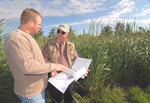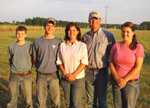Indiana
 Conservation
Practices Weather the Storm
Conservation
Practices Weather the Storm
(from USA Agnet) If you traveled rural roads in southern or west central
Indiana in June, you had plenty of chances to see fields and roads that were
flooded, bridges and culverts that were washed out, and other damage caused by
the heavy rains and flooding. But you might not have noticed the many
conservation practices that were not washed out, but held and did their job to
filter sediment and nutrients in the water running across them.
Mississippi
 International
Delegation Learns About NRCS Customer Outreach
International
Delegation Learns About NRCS Customer Outreach
One of the stops for six international delegates from Kazakhstan, Tajikistan,
and Uzbekistan was the Mississippi NRCS Pearl Area Office where they learned
about outreach to NRCS customers.
Texas
 Students
Study Soils at Wildlife Conservation Camp
Students
Study Soils at Wildlife Conservation Camp
The Nature Conservancy’s Davis Mountains Preserve was the site for the recent
Texas Chapter of the Wildlife Society’s Wildlife Conservation Camp. Each
summer the camp hosts up to 25 high school sophomores, juniors, and seniors from
around the State. This year, 17 students attended the camp to learn about
wildlife biology, ecology, management, and conservation.
Washington
 Conservation
Buffers Yield Wildlife, Water Quality Thanks to Farm Family’s Dedication
Conservation
Buffers Yield Wildlife, Water Quality Thanks to Farm Family’s Dedication
A few weeks ago, eight-year-old Campbell Schulke set out to capture a
crawfish from Dry Creek. But just ten years previous, before miles of
trees, shrubs, and grasses were established, his chances of finding any life
along Dry Creek were close to nil, according to his father, Jeff Schulke.

 South Carolina Family Farm Receives Regional Environmental Stewardship Award
South Carolina Family Farm Receives Regional Environmental Stewardship Award
(from the Aiken Standard) Yon Family Farms in Ridge Spring, South Carolina, received the regional 2008
Environmental Stewardship award from the National Cattlemen's Beef Association
for their commitment to being environmentally conscious while providing consumers
with safe beef products. The primary product out of Yon Family Farms is
registered Angus beef (click on image to
enlarge).

 The following requires
The following requires
 Adobe Acrobat.
Adobe Acrobat.
Jennifer
Salak -- Nebraska NRCS Earth Team Volunteer
As a graduate student studying public affairs, one of Jennifer Salak's degree
requirements was to complete an internship. She wanted to intern at an
organization that was dedicated to conservation and the environment so NRCS was
a good fit.

The following requires
 Adobe Acrobat.
Adobe Acrobat.
 Hari
Eswaran Profiled in Smithsonian Soils Exhibit
Hari
Eswaran Profiled in Smithsonian Soils Exhibit
NRCS National Leader for World Soil
Resources Hari Eswaran is profiled in the
Smithsonian National Museum of Natural History
Dig-It Secrets of Soil exhibit.
 Pollinator
Tent Featured at USDA Farmers Market
Pollinator
Tent Featured at USDA Farmers Market
Pollinator enhancement and protection literature, the new Bounty of Bees
pollinator poster, and other information from USDA pollinator partners and the
National Honey Board were recently featured at a USDA Farmers Market
exhibit tent in Washington DC. Pursuit of providing such
awareness-building materials at farmers markets across the nation is being
pursued through the USDA Agricultural Marketing Service.
Your contact is NRCS Pollinator Coordinator
Doug Holy at 202-720-9096.

 Knowledge
Sharing Eases Adoption of Civil 3D 2008
Knowledge
Sharing Eases Adoption of Civil 3D 2008
NRCS recently purchased a new generation of computer-aided drafting and design
(CAD) software called AutoCAD Civil 3D. This model based design software is
quite different in functionality compared to previous versions of design
software that NRCS has used.

 Soil
Erosion Service
Soil
Erosion Service
When the Soil Erosion Service was created in 1933 under the U.S. Department of
the Interior, Hugh Hammond Bennett became its director. Using equipment
and seeds supplied by the government and labor provided by men enrolled in
federal job programs such as the Civilian Conservation Corps and the Works
Progress Administration, the Soil Erosion Service was able to build support among
farmers and show them how to reduce erosion on their land (click
to enlarge image).
NRCS This Week features a weekly historical photo and caption. NHQ,
districts, States, RC&D councils, and all other NRCS entities are invited to
submit a historical photo of activities or individuals who have worked or are
working for the agency along with a caption.
| Conservation... Our Purpose. Our Passion The purpose and
passion for conservation is shared among many. It is shared between NRCS
employees and partners who help people help the land. And it is shared
by the landowners with whom we work. Our passion is manifested through
the benefits derived from stewardship of private lands—benefits we all
enjoy, such as cleaner water and air, improved soils and abundant
wildlife habitat.
Learn about our stories, the stories of conservation made possible
through a shared purpose, a shared passion and a shared commitment to
conservation. |
| |
The U.S. Department of Agriculture (USDA) prohibits discrimination in all its
programs and activities on the basis of race, color, national origin, age,
disability, and where applicable, sex, marital status, familial status, parental
status, religion, sexual orientation, genetic information, political beliefs,
reprisal, or because all or a part of an individual's income is derived from any
public assistance program. (Not all prohibited bases apply to all programs.)
Persons with disabilities who require alternative means for communication of
program information (Braille, large print, audiotape, etc.) should contact
USDA's TARGET Center at (202) 720-2600 (voice and TDD). To file a complaint of
discrimination write to USDA, Director, Office of Civil Rights, 1400
Independence Avenue, S.W., Washington, D.C. 20250-9410 or call (800) 795-3272
(voice) or (202) 720-6382 (TDD). USDA is an equal opportunity provider and
employer,

 Soil
Erosion Service
Soil
Erosion Service